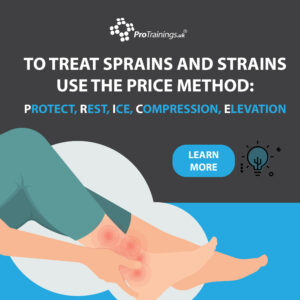Sprains and Strains:
How to Recognise and Treat Soft Tissue Injuries
Sprains and strains are common injuries that affect the muscles, ligaments, and tendons. While they are not usually life-threatening, they can be very painful and may limit movement. Proper first aid for these injuries can help alleviate pain, reduce swelling, and promote faster healing.
What is a Sprain?
A sprain occurs when the ligaments – the tough bands of tissue that connect bones at a joint – are stretched or torn. Sprains most often happen in the ankles, knees, wrists, or thumbs due to sudden twists, falls, or impacts.
What is a Strain?
A strain is an injury to a muscle or tendon – the tissues that connect muscles to bones – and occurs when these tissues are overstretched or torn. Strains usually happen in the lower back, legs (particularly the hamstrings), or arms due to overexertion or improper lifting.
Signs and Symptoms of a Sprain
- Pain: Severe pain at the site of the injury, especially when attempting to move the affected joint.
- Swelling: The injured area may swell quickly, indicating inflammation of the surrounding tissues.
- Bruising: Discolouration may occur around the joint as a result of bleeding under the skin.
- Limited Movement: The joint may be difficult or impossible to move without pain.
- Instability: The joint may feel unstable, weak, or as though it will give way when you try to put weight on it.
Signs and Symptoms of a Strain
- Pain: Immediate pain in the muscle or tendon, often increasing when you try to move the affected limb.
- Muscle Spasms: The injured muscle may feel tight or go into spasm.
- Swelling: The injured area may become swollen and tender to touch.
- Limited Range of Motion: It may be difficult to use the affected muscle or tendon without experiencing pain.
First Aid for Sprains and Strains: The PRICE Method
The PRICE method (Protect, Rest, Ice, Compression, Elevation) is an effective way to treat sprains and strains during the first 48 hours following an injury. This helps to reduce pain, swelling, and promote healing.
- Protection:
- protect the injury, for example by using a support, or shoes that support your foot or ankle.
- Rest:
- Avoid putting weight on the injured area, and rest the affected joint or muscle. Resting the injury prevents further damage and allows the healing process to begin.
- In some cases, you may need to use crutches or a sling to immobilise the injury, especially if walking or moving causes pain.
- Ice:
- Apply an ice pack (or a bag of frozen peas wrapped in a cloth) to the injured area for up to 20 minutes every 2-3 hours during the first 48 hours.
- Ice helps to reduce swelling and numb the area, relieving pain. However, do not apply ice directly to the skin as this can cause ice burns.
- Compression:
- Use an elastic bandage or a compression wrap to gently compress the injured area, during the day this helps limit swelling and provides support to the joint or muscle.
- Ensure the bandage is snug but not too tight, as restricting blood flow could cause further damage. If you feel tingling, numbness, or increased pain, loosen the bandage.
- Elevation:
- Elevate the injured limb above the level of the heart whenever possible. This helps to reduce swelling by allowing fluids to drain away from the injured area.
- Use pillows to support the limb while resting.
Managing Pain and Swelling
- Over-the-counter Pain Relief: Non-steroidal anti-inflammatory drugs (NSAIDs) like ibuprofen can help manage pain and reduce inflammation. Always follow the recommended dosage and consult a healthcare professional if needed.
- Avoid Heat: During the first 48 hours, avoid using heat packs or hot baths, as these can increase swelling.
- Gradual Return to Activity: Once the swelling has gone down and pain has decreased, slowly begin to use the injured area again. Gentle movement helps to maintain flexibility and strength, but avoid overexerting the joint or muscle until it has fully healed.
When to Seek Medical Help
While many sprains and strains can be treated at home, seek medical attention if:
- The pain is severe or worsening over time.
- The joint appears deformed or unstable.
- You cannot put any weight on the injured area.
- There is numbness, tingling, or loss of movement in the injured limb.
- The swelling or bruising is extensive.
- The injury does not improve after a few days of home treatment.
In some cases, what may seem like a sprain or strain could be a more serious injury, such as a fracture or dislocation, which will require professional medical treatment.
Preventing Sprains and Strains
- Warm Up Properly: Before any physical activity, take time to warm up your muscles and stretch to reduce the risk of injury.
- Use Proper Technique: When lifting heavy objects, use proper lifting techniques to avoid straining your back or other muscles.
- Wear Supportive Footwear: Ensure you wear shoes that provide good support, particularly during physical activities or sports.
- Strengthen Muscles: Regular exercises to strengthen the muscles around your joints can help prevent future sprains or strains.
Key Points to Remember
- Use the PRICE method: Protect, Rest, Ice, Compression, and Elevation to treat sprains and strains.
- Seek medical help if there is severe pain, instability, or if the injury does not improve after a few days.
- Prevent sprains and strains by warming up properly, using the correct techniques for physical activities, and wearing appropriate footwear.
